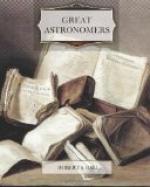COPERNICUS
[Plate: Thorn, from an old print.]
The quaint town of Thorn, on the Vistula, was more than two centuries old when Copernicus was born there on the 19th of February, 1473. The situation of this town on the frontier between Prussia and Poland, with the commodious waterway offered by the river, made it a place of considerable trade. A view of the town, as it was at the time of the birth of Copernicus, is here given. The walls, with their watch-towers, will be noted, and the strategic importance which the situation of Thorn gave to it in the fifteenth century still belongs thereto, so much so that the German Government recently constituted the town a fortress of the first class.
Copernicus, the astronomer, whose discoveries make him the great predecessor of Kepler and Newton, did not come from a noble family, as certain other early astronomers have done, for his father was a tradesman. Chroniclers are, however, careful to tell us that one of his uncles was a bishop. We are not acquainted with any of those details of his childhood or youth which are often of such interest in other cases where men have risen to exalted fame. It would appear that the young Nicolaus, for such was his Christian name, received his education at home until such time as he was deemed sufficiently advanced to be sent to the University at Cracow. The education that he there obtained must have been in those days of a very primitive description, but Copernicus seems to have availed himself of it to the utmost. He devoted himself more particularly to the study of medicine, with the view of adopting its practice as the profession of his life. The tendencies of the future astronomer were, however, revealed in the fact that he worked hard at mathematics, and, like one of his illustrious successors, Galileo, the practice of the art of painting had for him a very great interest, and in it he obtained some measure of success.
By the time he was twenty-seven years old, it would seem that Copernicus had given up the notion of becoming a medical practitioner, and had resolved to devote himself to science. He was engaged in teaching mathematics, and appears to have acquired some reputation. His growing fame attracted the notice of his uncle the bishop, at whose suggestion Copernicus took holy orders, and he was presently appointed to a canonry in the cathedral of Frauenburg, near the mouth of the Vistula.




